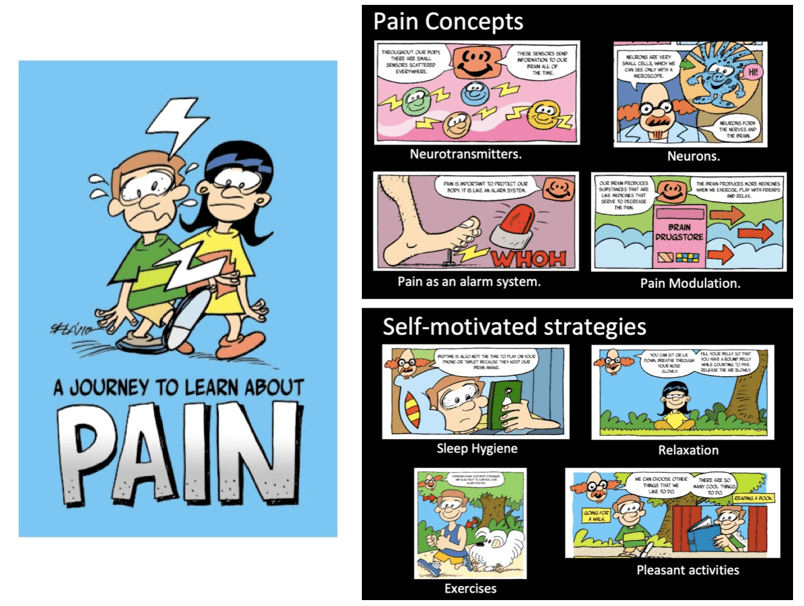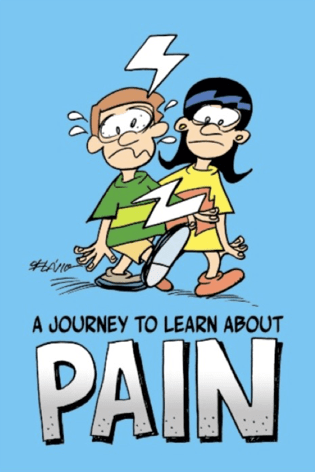Persistent pain in children is an increasingly recognized clinical problem with high prevalence rates found in some populations. A conservative estimate posits that 20% to 35% of children and adolescents are affected by persistent pain worldwide (1). The most commonly reported pain problems in children and adolescents are headache; abdominal pain; musculoskeletal pain and multiple site pain (2). Pain prevalence rates were higher in girls and increased with age for most pain types. In the current view, persistent pain is the result of a dynamic interaction between multiple contributors, including nociceptive, affective, sociocultural, behavioral, and cognitive (3). Children and adolescents who suffer with persistent pain exhibit not only physical symptoms but also have to deal with psychological distress and social restriction (4). It is also important to recognise that children who report persistent pain, are at increased risk of persistent pain as adults
Pain Neuroscience Education (PNE) aims to explain to patients the neurophysiological processes involved in a pain experience(5). PNE may be beneficial for several outcomes in adult who suffer from persistent pain (6).
In addition to PNE, self-motivated coping strategies are relevant to people with persistent pain. Self-motivated strategies focus on educating people about cognitive and behavioural skills to cope with pain and help them to become more actively involved in managing their symptoms. Several self-motivated strategies have been reported in the literature and include sleep hygiene, relaxation programs, return to activities, practicing exercises and coping skills programs (7) .
To date, most research in pediatrics has focused on pain management rather than explaining pain neuroscience and biology to patients or behavioral modification (8). Considering this gap in the literature, we assembled pain specialists including Adriaan Louw, Tonya Palermo, Kelly Ickmans, Ney Meziat and Leandro Nogueira and suggested that we develop a book about PNE and self-motivated coping strategies for children.
The first step in the development of the book was the identification of the content that comprises PNE. A systematic review suggested that PNE should include: neurophysiology of pain, the difference between nociception and pain, neuron anatomy and function, spinal inhibition and facilitation, peripheral sensitization, central sensitization and plasticity of the nervous system (9). The second step was the most challenging and consisted of adaptation of the concepts for children. We undertook to do this in illustrated story form. The third step was the validation of the book. In this step, a panel of specialists in pain in children from different parts of the globe were invited to judge the book (content, language and illustrations). The last step was to present the book to the target population (the Portuguese version), parents, caregivers and teachers to judge whether the book is interesting for children from eight to twelve-years-old.
The result of this process was the development of a cartoon book entitled “A Journey to Learn about Pain”. The story revolves around three main characters. The main character, Fred is an eight-year-old boy who suffers from headache and abdominal pain. Clara is Fred’s best friend and she is worried about his pain. Clara invited Fred to visit Professor Dexter, a very smart scientist who can explain a lot of things. Clara and Fred go to Professor Dexter lab in order to find information about pain and how to deal with it. During the story Professor Dexter uses his supercomputer to explain pain concepts and behavioral strategies to deal with pain. The book is freely available on our website and can be downloaded in different formats or also read online in flipbook.
 We recognize that the development of the book does not guarantee clinical efficacy. Therefore, it is important to evaluate this intervention as a support to clinicians in future studies. We also believe that this book could be relevant if it is presented outside clinical settings such as added into the school curriculum.
We recognize that the development of the book does not guarantee clinical efficacy. Therefore, it is important to evaluate this intervention as a support to clinicians in future studies. We also believe that this book could be relevant if it is presented outside clinical settings such as added into the school curriculum.
About Felipe Reis
 Prof. Felipe Reis is is a Physiotherapy professor at the Instituto Federal do Rio de Janeiro (IFRJ). He works in the Advanced Neuroimaging Laboratory at Universidade Federal do Rio de Janeiro (UFRJ) developing research about Neuroscience of Emotion, Cognition, Behavior and Pain. In the last years, he is working as a researcher collaborator at McGill University. He is also the coordinator of the Pesquisa em Dor website. Recently, he was elected as the new chair of the Pain, Mind and Movement Special Interested Group of IASP.
Prof. Felipe Reis is is a Physiotherapy professor at the Instituto Federal do Rio de Janeiro (IFRJ). He works in the Advanced Neuroimaging Laboratory at Universidade Federal do Rio de Janeiro (UFRJ) developing research about Neuroscience of Emotion, Cognition, Behavior and Pain. In the last years, he is working as a researcher collaborator at McGill University. He is also the coordinator of the Pesquisa em Dor website. Recently, he was elected as the new chair of the Pain, Mind and Movement Special Interested Group of IASP.
References
[1] Stanford EA, Chambers CT, Biesanz JC, Chen E. The frequency, trajectories and predictors of adolescent recurrent pain: A population-based approach. Pain. 2008;138(1):11–21.
[2] King S, Chambers CT, Huguet A, MacNevin RC, McGrath PJ, Parker L, et al. The epidemiology of chronic pain in children and adolescents revisited: a systematic review. Pain. 2011;152(12):2729–38.
[3] Liossi C, Howard RF. Pediatric chronic pain: biopsychosocial assessment and formulation. Pediatrics. 2016;138(5):e20160331.
[4] Walker LS, Garber J, Greene JW. Psychosocial correlates of recurrent childhood pain: a comparison of pediatric patients with recurrent abdominal pain, organic illness, and psychiatric disorders. J Abnorm Psychol. 1993;102(2):248.
[5] Moseley GL, Butler DS. Fifteen Years of Explaining Pain: The Past, Present, and Future. J PAIN. 2015;16(9):807–13.
[6] Louw A, Zimney K, Puentedura EJ, Diener I. The efficacy of pain neuroscience education on musculoskeletal pain: A systematic review of the literature. Physiother Theory Pract. 2016;32(5):332–55.
[7] Eccleston C, Palermo TM, Williams A, Lewandowski A, Morley S. Psychological therapies for the management of chronic and recurrent pain in children and adolescents. Cochrane Database Syst Rev. 2009;2(2):CD003968.
[8] Robins H, Perron V, Heathcote LC, Simons LE. Pain Neuroscience Education: State of the Art and Application in Pediatrics. Children. 2016;3(4):43.
[9] Louw A, Diener I, Butler DS, Puentedura EJ. The Effect of Neuroscience Education on Pain, Disability, Anxiety, and Stress in Chronic Musculoskeletal Pain. Arch Phys Med Rehabil. 2011;92(12):2041–56.



